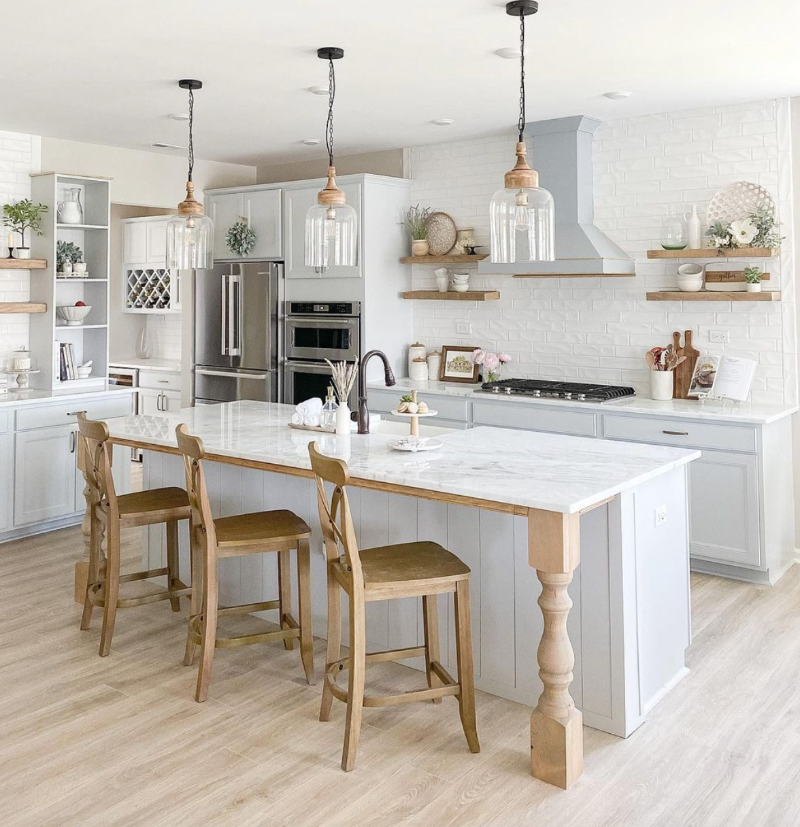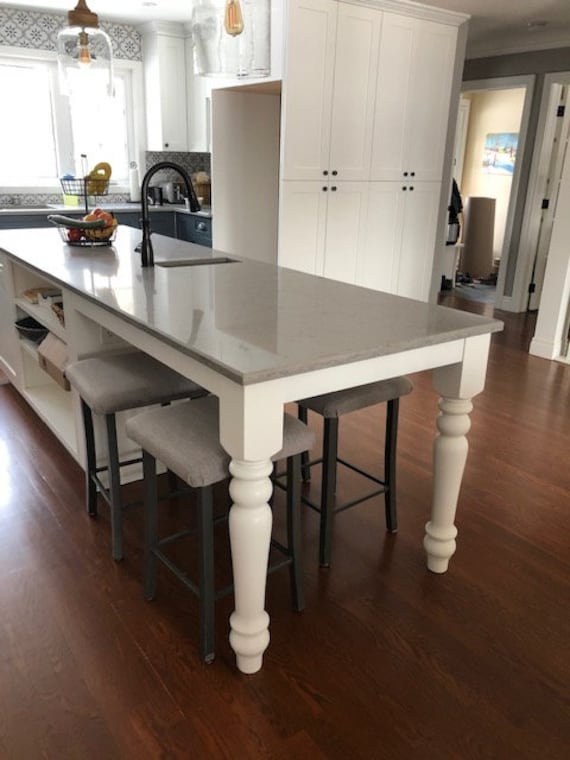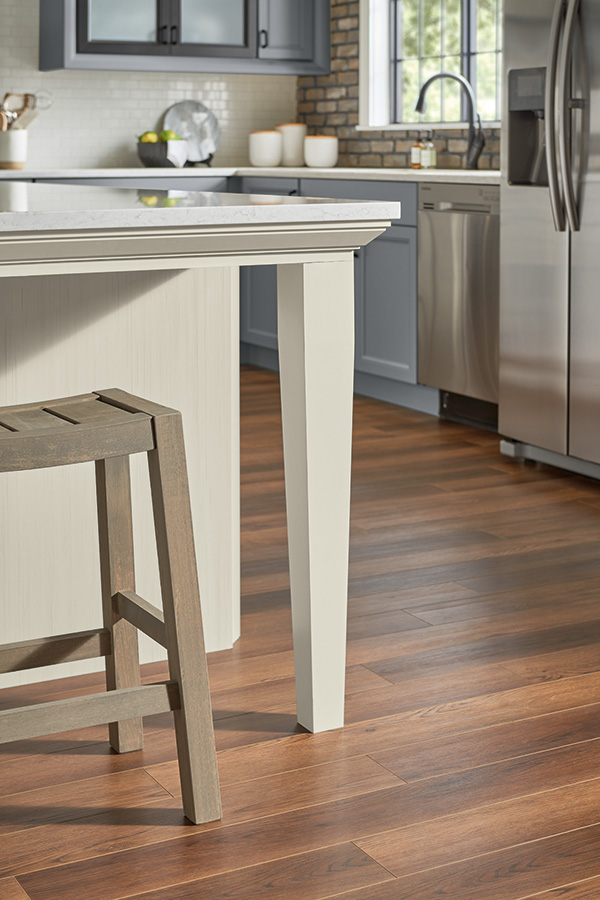Transform Your Kitchen With a Sleek Island With Legs for Extra Workspace
In contemporary kitchen area style, the consolidation of a streamlined island with legs has actually arised as a sensible yet fashionable remedy for boosting workspace. This functional centerpiece not only provides added surface for dish prep work yet likewise adds to a contemporary visual that can balance with different design styles. The unique design of the legs allows for a feeling of visibility, promoting movement and communication within the kitchen area setting. As we explore the diverse advantages of this style selection, it comes to be clear that it can redefine the culinary experience in unanticipated methods.
Advantages of a Kitchen Island
Enhancing the capability and visual appeal of a cooking area, a kitchen area island acts as a functional centerpiece in modern-day culinary rooms. One of the key advantages of a kitchen island is its capability to provide added work area, facilitating dish preparation and different cooking tasks. This added area is indispensable for those that take pleasure in cooking and need room for numerous ingredients and devices.
Additionally, a kitchen island can boost social interaction, producing a gathering point for family members and buddies. It urges informal dining and discussion, making it an ideal place for informal meals, snacks, or beverages while dishes are being prepared.
Additionally, kitchen area islands supply ample storage remedies, often integrating closets or shelves that assist declutter kitchen counters (kitchen island with legs). This organization adds to a much more reliable cooking setting, where important products are quickly obtainable
In addition, islands can accommodate different appliances, such as cooktops or sinks, mixing usefulness with layout. They can raise the general aesthetic of the kitchen area, allowing for personalization through materials, colors, and styles that complement the home's decor. In summary, a kitchen island is a multifaceted addition that enhances both functionality and livability in culinary spaces.
Choosing the Right Design
When selecting the right layout for a cooking area island, it is necessary to take into consideration both the performance and style that best match the area. The island ought to harmonize with the existing cooking area decoration, whether it be contemporary, rustic, or traditional. Materials play an essential duty; choices like wood, quartz, or stainless steel can affect the overall visual and longevity.
Dimension is another critical aspect. Guarantee the island is proportional to the kitchen area, permitting appropriate pathways and accessibility (kitchen island with legs). A properly designed island should not block traffic circulation or hinder motion in between home appliances

Consider integrating features such as open shelving or integrated storage space to boost performance without endangering style. Lights is just as vital; pendant lights can add aesthetic rate of interest while providing enough illumination for jobs. Eventually, the right style must show individual taste while fulfilling useful demands, making the kitchen area both useful see this website and inviting.
Maximizing Workspace Effectiveness
Efficiency in the kitchen area can considerably boost the overall food preparation experience, making it necessary to take full advantage of work space efficiently. A properly designed kitchen island can act as the core of culinary tasks, giving sufficient surface location for food cooking, prep work, and plating. To optimize this area, think about incorporating multifunctional aspects such as built-in cutting boards, pull-out drawers, or shelving that maintains essential tools and active ingredients within arm's reach.
Additionally, the tactical placement of the island in regard to various other cooking area components is essential. Placing the island near the oven and fridge permits seamless workflow, reducing unnecessary motion. Carrying out open hanging or shelving storage can likewise lower mess, ensuring that utensils and spices are easily accessible.

Inevitably, a thoughtfully designed kitchen island optimizes work space performance, enabling a smoother cooking process and creating a more enjoyable kitchen environment. By prioritizing organization and accessibility, you can transform your cooking room right into a center of efficiency.
Styling Your Island With Decoration

Begin by picking a shade scheme that matches your existing design. Incorporate ornamental aspects such as flower holders, bowls, or trays to display seasonal fruits or fresh blossoms, including a touch of all-natural elegance. Consider using stylish containers to arrange cooking area basics, making certain that your island continues to be clutter-free while improving its visual appeal.
Layering is key; utilize different elevations and textures to hop over to here produce aesthetic rate of interest. Stack cookbooks or position a posh reducing board together with your ornamental products. This find not only improves accessibility yet additionally presents an inviting atmosphere
Lighting is an additional crucial facet. Pendant lights above the island can give lighting while acting as a design declaration. Decide for fixtures that harmonize with your cooking area's total style, whether contemporary, rustic, or eclectic.
Maintenance Tips for Long Life
To ensure your kitchen island continues to be a sensational centerpiece for years ahead, regular upkeep is necessary. Start by cleaning up the surface regularly with a moderate soap and water solution, staying clear of severe chemicals that can harm the surface. For wood surfaces, take into consideration using a dedicated timber cleaner and applying a food-safe mineral oil occasionally to keep its radiance and protect against dampness.
Examine the legs and any kind of hardware regularly for signs of wear or looseness. If your island includes a kitchen counter made of stone or quartz, use coasters and reducing boards to protect against scratches and stains.
Furthermore, stay clear of positioning warm pots or pans directly externally, as this can trigger thermal shock and cause damages. Address them quickly with suitable repair work sets created for your island's material if you observe any type of dents or scratches. By adhering to these maintenance suggestions, your kitchen island will not only retain its visual allure yet additionally offer you well for many years to find.
Conclusion
Including a smooth kitchen island with legs dramatically improves both capability and aesthetic allure. Adhering to upkeep suggestions even more ensures the durability of the island, solidifying its function as an essential function in modern kitchen area layout.
In contemporary cooking area design, the unification of a sleek island with legs has arised as a useful yet fashionable solution for boosting workspace.Enhancing the performance and visual appeal of a cooking area, a kitchen island serves as a flexible focal point in modern culinary rooms. In recap, a kitchen island is a diverse enhancement that enhances both functionality and livability in cooking areas.
When choosing the right design for a cooking area island, it is vital to take into consideration both the capability and style that ideal suit the space. Sticking to maintenance ideas further guarantees the durability of the island, strengthening its duty as an essential function in contemporary cooking area layout.